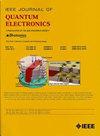不同脉冲条件下多结VCSELs中多氧化层的影响
IF 2.1
3区 工程技术
Q3 ENGINEERING, ELECTRICAL & ELECTRONIC
引用次数: 0
摘要
本文研究了不同脉冲驱动条件下940 nm三结垂直腔面发射激光器(VCSELs),重点研究了氧化层结构对电学和光学性能的影响。热积累是VCSEL运行中的关键问题;因此,减小脉冲宽度可以有效地减少热量的产生。这不仅提高了器件的热特性,而且抑制了横向载流子扩散,这在较长的谐振腔结构(如多结VCSELs)中尤为重要。在室温下,由2 ns脉冲驱动的3J 940 nm氧化孔径为$10\mu $ m的VCSEL,采用三层氧化结构的斜率效率(SE)为3.2 W/ a,而单层氧化结构的斜率效率为2.37 W/ a。两种器件的红光谱位移均小于1 nm,对应的温升低于$12~^{\circ}$ C,表明热管理得到改善。值得注意的是,在三氧化层3J VCSEL中观察到一个独特的行为:随着注入电流的增加,光束发散角从17°减小到5°。这些发现突出了具有优化氧化物设计的多结vcsel的优势,展示了它们在未来高性能传感应用中的潜力。本文章由计算机程序翻译,如有差异,请以英文原文为准。
Effects of Multiple Oxide Layers in Multi-Junction VCSELs Under Different Pulse Conditions
This report investigates 940 nm vertical-cavity surface-emitting lasers (VCSELs) with three-junction (3J) designs under various pulsed driving conditions, focusing on the influence of oxide layer configurations on electrical and optical performance. Heat accumulation is a critical issue in VCSEL operation; therefore, reducing pulse width effectively minimizes heat generation. This not only enhances the thermal characteristics of the devices but also suppresses lateral carrier diffusion—particularly important in longer resonant cavity structures such as multi-junction VCSELs. At room temperature, a 3J 940 nm VCSEL with a $10\mu $ m oxide aperture driven by 2 ns pulses achieved a slope efficiency (SE) of 3.2 W/A using a three-layer oxide structure, compared to 2.37 W/A for a single-layer oxide design. Both devices exhibited a red spectral shift of less than 1 nm, corresponding to a temperature rise below $12~^{\circ }$ C, indicating improved thermal management. Notably, a unique behavior was observed in the three-oxide-layer 3J VCSEL: as the injection current increased, the beam divergence angle decreased from 17° to 5°. These findings highlight the advantages of multi-junction VCSELs with optimized oxide designs, demonstrating their potential for future high-performance sensing applications.
求助全文
通过发布文献求助,成功后即可免费获取论文全文。
去求助
来源期刊

IEEE Journal of Quantum Electronics
工程技术-工程:电子与电气
CiteScore
4.70
自引率
4.00%
发文量
99
审稿时长
3.0 months
期刊介绍:
The IEEE Journal of Quantum Electronics is dedicated to the publication of manuscripts reporting novel experimental or theoretical results in the broad field of the science and technology of quantum electronics. The Journal comprises original contributions, both regular papers and letters, describing significant advances in the understanding of quantum electronics phenomena or the demonstration of new devices, systems, or applications. Manuscripts reporting new developments in systems and applications must emphasize quantum electronics principles or devices. The scope of JQE encompasses the generation, propagation, detection, and application of coherent electromagnetic radiation having wavelengths below one millimeter (i.e., in the submillimeter, infrared, visible, ultraviolet, etc., regions). Whether the focus of a manuscript is a quantum-electronic device or phenomenon, the critical factor in the editorial review of a manuscript is the potential impact of the results presented on continuing research in the field or on advancing the technological base of quantum electronics.
 求助内容:
求助内容: 应助结果提醒方式:
应助结果提醒方式:


